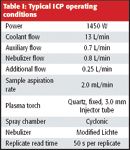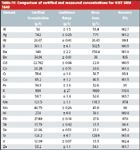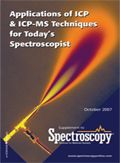Analysis of Drinking Water Using ICP-OES
The multielement analysis of water is one of the major applications for inductively coupled plasma-optical emission spectroscopy (ICP-OES). This report describes the analysis of metals and trace elements in drinking water in terms of sensitivity, precision, and accuracy. Instrument parameters and line selection are described. Excellent recoveries were found for the standard reference material (SRM) NIST SRM 1640.
Clean, fresh water is essential to life. Unfortunately, since the industrial revolution, waterways and coastal waters have become polluted, harming human health. In the past few decades, significant progress in the treatment of sewage and industrial wastes has been made. As a result, levels of most pollutants have decreased and a measurable improvement in water quality has been achieved.
In order to protect human health from the adverse effects of any contamination of water intended for human consumption, the World Health Organization (WHO) has defined minimum standards in its "Guidelines for drinking water quality" (1). For the countries of the European Union, "Directive 98/83/EC on the quality of water intended for human consumption" (2) has been passed by the European Council to define the essential quality standards. In the U.S., the quality of drinking water is defined through the "Safe Drinking Water Act" (3) and the "National Primary Drinking Water Regulations," (4) setting maximum levels for contaminants (5). Because of its multielement determination capability, high dynamic linear range, and sensitivity, inductively coupled plasma-optical emission spectroscopy (ICP-OES) is used widely for the analysis of drinking water. The application is described in several ICP-OES standard procedures, such as US-EPA Method 200.7 (6) and ISO 11885 (7). This article describes the ICP-OES analysis of drinking water, including the line selection, detection limits, and studies on precision and accuracy.
Experimental
Instrumentation
All measurements were performed with the SPECTRO ARCOS optical emission spectrometer (SPECTRO Analytical Instruments, Kleve, Germany) with axial plasma observation. The instrument features a Paschen–Runge spectrometer mount, employing the proprietary Optimized Rowland Circle Alignment (ORCA) technique. Consisting of two hollow section cast shells, optimized small volume, and 32 linear charge-coupled-device detectors (CCDs), the wavelength range between 130 and 770 nm can be analyzed simultaneously, allowing complete spectrum capture within 2 s. Because of the unique reprocessing capabilities of the system, a new measurement is not required even if additional elements or lines are to be determined at a later date.
The optic is sealed hermetically and filled with argon and continuously circulated through a filter, which absorbs oxygen, water vapor, and other species. High optical transmission in the vacuum ultraviolet (VUV) is achieved, allowing the determination of nonmetals as well as the use of prominent and interference-free lines in this region.
Utilizing Intelligent Calibration Logic (ICAL), which normalizes the wavelength scale, the state of the optical system is monitored automatically.
An air-cooled ICP-generator, based upon a free-running 27.12-MHz system, is installed, which ensures stability of the forward power with rapidly changing sample loads. All relevant ICP operating parameters are software-controlled, allowing easy selection of the optimum operating conditions. For sample introduction, a modified Lichte nebulizer with a cyclonic spray chamber was used. The operating conditions are given in Table I.

Table I: Typical ICP operating conditions
Calibration Standards
For calibration, commercially available standard solutions were used. The concentrations of the elements are given in Table II. The quality control of the method was performed using NIST standard reference material (SRM) 1640, "Trace Elements in Natural Water." All solutions were acidified with 1% nitric acid, suprapure quality.

Table II: Calibration standards
Results and Discussion
Table III shows the wavelengths selected and the limits of detection (LOD). The LODs were calculated according to the following equation (8):
LOD = 3 RSDb c/SBR

Table III: Limits of detection (LOD) of the selected lines
where RSDb is the relative standard deviation of 10 replicates of the blank, C is the concentration of the standard, and SBR is the signal to background ratio.
Accuracy
The accuracy and precision of the method were investigated by analyzing SRM 1640 ("Trace Elements in Natural Water"). As shown in Table IV, the measured values and the certified values are in excellent agreement for all the elements.

Table IV: Comparison of certified and measured concentrations for NIST SRM 1640
Conclusions
ICP-OES with axial plasma observation offers a simple, fast, accurate, precise, and cost-efficient method for the analysis of drinking water. Excellent recoveries were determined for NIST SRM 1640. In conjunction with an autosampler, the ICP-OES instrument can be fully automated for water analysis. Independent from the number of lines and elements, an analysis (including three replicates pre-flush, and method rinse) can be performed in less than 3 min.
Dirk Ardelt, Peter Ivanov, and Olaf Schulz are with Spectro Analytical Instruments GmbH & Co KG, Kleve, Germany.
References
(1) World Health Organization 1998, Guidelines for drinking water quality, Second Edition.
(2) Council Directive 98/83/EC of 3rd November 1998 on the quality of water for human consumption.
(3) Safe Drinking Water Act, 42 USC Sec. 300f.
(4) 40 CFR 141 National Primary Drinking Water Regulations.
(5) EPA 816-F-03-016 — List of Contaminants and Their Maximum Contaminant Levels (MCL).
(6) Method 200.7 Determination of metals and trace elements in water and wastes by inductively coupled plasma atomic emission spectroscopy Rev. 4.4.
(7) ISO 11885 (1998).
(8) P.W.J.M. Boumans, Spectrochim. Acta 46B, 431 (1991).

Trending on Spectroscopy: The Top Content of 2024
December 30th 2024In 2024, we launched multiple content series, covered major conferences, presented two awards, and continued our monthly Analytically Speaking episodes. Below, you'll find a selection of the most popular content from Spectroscopy over the past year.
Best of the Week: Hyperspectral Imaging, ICP-MS Analysis of Geological Samples, Product Roundup
October 18th 2024Top articles published this week include an article about hyperspectral imaging in human skin research, a peer-reviewed article about analyzing geological samples using atomic spectroscopy techniques, and an equipment roundup piece about the latest products in the industry.